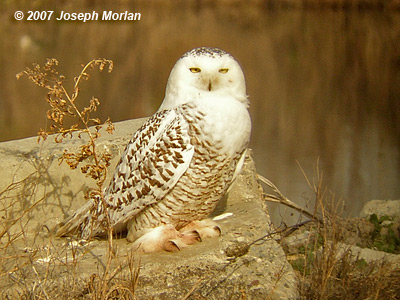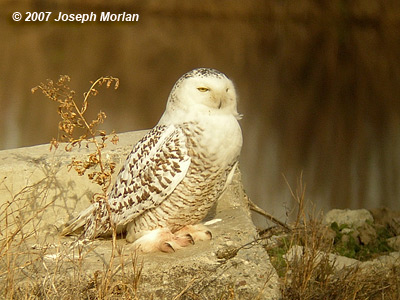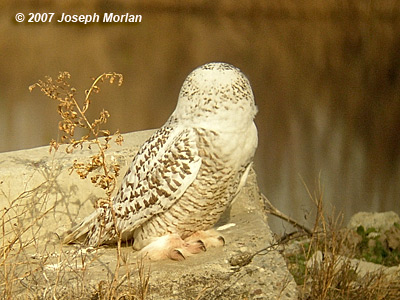Snowy Owl (Bubo scandiacus)
Grizzly Bay, Solano County, California
19 January 2007
Joseph Morlan
Photos © 19 January 2007 by Joseph Morlan. All rights reserved. Click here and here for full sized
images.
 This afternoon, Robbie
Fischer and I enjoyed a pleasant five hour cruise aboard the "California
Sunset" out of Suisun City. We were joined by many other birders, some from as far away as San Diego.
This stable boat, combined with light winds made for smooth sailing. In fact, it was so smooth that I was able
to digiscope from the upper deck. The highlight of the trip was this Snowy Owl which has been in the area for about
3 weeks and which is now being seen daily on these cruises. This species is a rarity anywhere in California and
this individual has generated considerable interest. I took these photos with an Olympus D-550z / Nikon FieldScope
3 / 30XWA (hand-held - no adapter). Today, the Snowy Owl was first spotted by Doug Aguillard when it was just a
white dot on distant rip-rap. As we approached the owl showed no fear and we were able to observe it at close range
for about a half hour (2:00-2:30pm) before returning to Suisun City.
This afternoon, Robbie
Fischer and I enjoyed a pleasant five hour cruise aboard the "California
Sunset" out of Suisun City. We were joined by many other birders, some from as far away as San Diego.
This stable boat, combined with light winds made for smooth sailing. In fact, it was so smooth that I was able
to digiscope from the upper deck. The highlight of the trip was this Snowy Owl which has been in the area for about
3 weeks and which is now being seen daily on these cruises. This species is a rarity anywhere in California and
this individual has generated considerable interest. I took these photos with an Olympus D-550z / Nikon FieldScope
3 / 30XWA (hand-held - no adapter). Today, the Snowy Owl was first spotted by Doug Aguillard when it was just a
white dot on distant rip-rap. As we approached the owl showed no fear and we were able to observe it at close range
for about a half hour (2:00-2:30pm) before returning to Suisun City.
Previously Snowy Owls were recorded in California during just seven winters: 1908-09 (1), 1916-17 (21), 1966-67
(5), 1973-74 (39), 1977-78 (3), and January 2006 (1). During a major invasion in 1896-97 flocks were reported in
the State as far south as Alameda, but details of that invasion are scant.
Description
It was a large white owl with extensive brown barring on the underparts and extensive brown wedges on the back,
scapulars and wing-coverts. The crown was streaked with blackish-brown, but the nape, face and upper chest were
pure white. The feet were enormous with pink blood-stained feathers extending all the way to the tips of the toes.
The bird did not fly during our observation, but frequently turned its head from side-to-side. The yellow eyes
seems partly closed most of the time.
Discussion
This bird was first seen 30 December 2006 by Charles A. Strickland who spotted it from a fishing boat and posted
a photo on the discussion board of the Coastside
Fishing Club. The bird is on the edge of property owned by the Gum Tree Duck Club.
There has been some speculation on whether this bird might be the same individual as the Snowy Owl seen 13-14
January 2006 along Liberty Island Road near the Solano/Yolo County border. Photos of that bird are here
and here. The Snowy Owl is extremely
rare in California and the idea that two different individuals would show up on successive winters in Solano County
seems improbable. To evaluate this possibility, we need to determine the age and sex of these birds.
A key paper on this subject is "Aging
and Sexing Snowy Owls" by B. Josephson (J. Field Ornith. 51:149-160, 1980). A summary from this article
follows:
la. Barring present on all areas of plumage except for white facial disk, tarsi, feet, and wing linings ......................................
FIRST-YEAR FEMALE
lb. Barring absent from parts of head or breast or other areas besides facial disk, tarsi, feet, and wing linings
................................................. 2
2a. Plumage entirely white or white except for narrow, sparse, pale gray or brown barring on breast, back, wings,
head, and/or tail ................. ADULT MALE
2b. Moderate or extensive barring present on breast, wings, head, and/or tail ....... 3
3a. Moderate or extensive mottling present on distal portions of greater and/or median secondary coverts .....................................................
4
3b. Mottling absent from distal portions of greater and/or median secondary coverts or very slight mottling present
.............................................. 5
4a. White bib of 2-8 cm present and back of head primarily white .......................................................................
FIRST-YEAR MALE
4b. White bib, if present, <4 cm and back of head primarily barred ......................................................................
FIRST-YEAR FEMALE
5a. White bib of <8 cm present and/or back of head primarily white ..........................................................................
ADULT FEMALE
5b. White bib absent or <4 cm and back of head primarily barred ................. 6
6a. Crissum with >6 bars .................................. FIRST-YEAR FEMALE
6b. Crissum white or with few (<6) bars or spots ...........................................................................
FEMALE, AGE UNDETERMINED
Using this key I scored our bird as follows: Barring absent from parts of head. Extensive barring (mottling)
present on wing coverts. White bib present and back of head primarily white. If this assessment is correct, the
bird is a first year male and thus is not the same bird which was present last year. The Snowy Owl seen 13-14 January
2006 was similarly analyzed by Dan Lockshaw here who concluded that
it was also a first year male. Peter Pyle analyzed video taken by Keith Hansen of the 13-14 January 2006 Snowy
Owl (details here) and agreed it was a first
winter male (second calendar year or SY in banding terminology). Lockshaw cited Kerlinger & Lein (1986) who
pointed out that first year males of this species routinely travel further south than any other age/sex class.
Additional Photos
Many additional photos have been posted on the web. Some of which I am aware are:
- 30 Dec. by Charles A. Strickland here
- 1 Jan. by John Sterling including map showing exact location here
- 2 Jan. by Ryan Terrill here
- 4 Jan by Wes Fritz here
- 5 Jan. by Steve Sosensky here
- 7 Jan. by David Wimpfheimer here
- 7 Jan by Rick LeBaudour here
- 19 Jan by David Jesus here
- 19 Jan by Douglas Aguillard here
References
Josephson, B.. 1980. Aging and sexing Snowy Owls. J. Field Ornith. 51: 149–160.
Kerlinger, P., M. R. Lein. 1986. Differences in winter range among age-sex classes of Snowy Owls Nyctea scandiaca
in North America. Ornis Scand. 17: 1–7.
Late Additions
 Peter Ginsberg has alerted
me to Kevin McGowan's site and another site
by Julian Hough, both of which take a slightly different approach to aging and sexing. Using characters from
those sites, it could be argued that the current Snowy Owl is an adult female because of the heavy markings on
its wings. However, the lightly marked white nape, deep white bib, and narrow broken tail bars (visible on a flight shot by Ryan Terrill
and by David Wimpfheimer) lead me to stay with my original conclusion of SY (second calendar year) male. The extent
of markings on the nape and the back of the head have turned out to be important, so I have added another photo
of the bird showing the back of the head (left).
Peter Ginsberg has alerted
me to Kevin McGowan's site and another site
by Julian Hough, both of which take a slightly different approach to aging and sexing. Using characters from
those sites, it could be argued that the current Snowy Owl is an adult female because of the heavy markings on
its wings. However, the lightly marked white nape, deep white bib, and narrow broken tail bars (visible on a flight shot by Ryan Terrill
and by David Wimpfheimer) lead me to stay with my original conclusion of SY (second calendar year) male. The extent
of markings on the nape and the back of the head have turned out to be important, so I have added another photo
of the bird showing the back of the head (left).
Dave Quady has pointed out that the many fine flight photos by Rick LeBaudour and others show no evidence of
molt; instead all feathers appear to be of the same generation. This observation further supports the contention
that this is an immature. Adults should show some evidence of wing molt.
As always, corrections and comments are welcome!
 This afternoon, Robbie
Fischer and I enjoyed a pleasant five hour cruise aboard the "California
Sunset" out of Suisun City. We were joined by many other birders, some from as far away as San Diego.
This stable boat, combined with light winds made for smooth sailing. In fact, it was so smooth that I was able
to digiscope from the upper deck. The highlight of the trip was this Snowy Owl which has been in the area for about
3 weeks and which is now being seen daily on these cruises. This species is a rarity anywhere in California and
this individual has generated considerable interest. I took these photos with an Olympus D-550z / Nikon FieldScope
3 / 30XWA (hand-held - no adapter). Today, the Snowy Owl was first spotted by Doug Aguillard when it was just a
white dot on distant rip-rap. As we approached the owl showed no fear and we were able to observe it at close range
for about a half hour (2:00-2:30pm) before returning to Suisun City.
This afternoon, Robbie
Fischer and I enjoyed a pleasant five hour cruise aboard the "California
Sunset" out of Suisun City. We were joined by many other birders, some from as far away as San Diego.
This stable boat, combined with light winds made for smooth sailing. In fact, it was so smooth that I was able
to digiscope from the upper deck. The highlight of the trip was this Snowy Owl which has been in the area for about
3 weeks and which is now being seen daily on these cruises. This species is a rarity anywhere in California and
this individual has generated considerable interest. I took these photos with an Olympus D-550z / Nikon FieldScope
3 / 30XWA (hand-held - no adapter). Today, the Snowy Owl was first spotted by Doug Aguillard when it was just a
white dot on distant rip-rap. As we approached the owl showed no fear and we were able to observe it at close range
for about a half hour (2:00-2:30pm) before returning to Suisun City.
 Peter Ginsberg has alerted
me to
Peter Ginsberg has alerted
me to